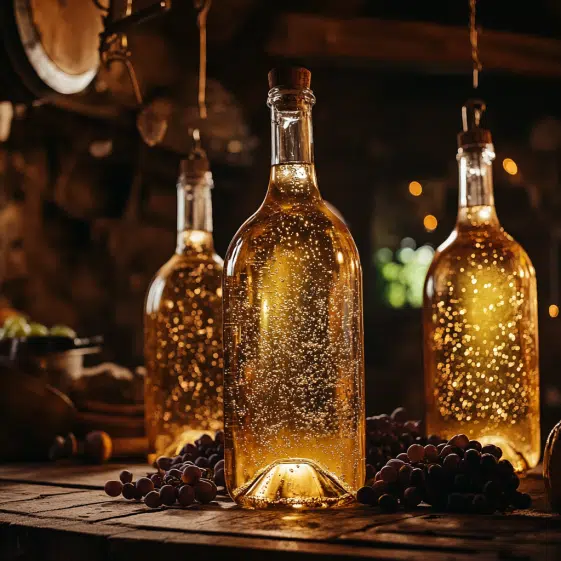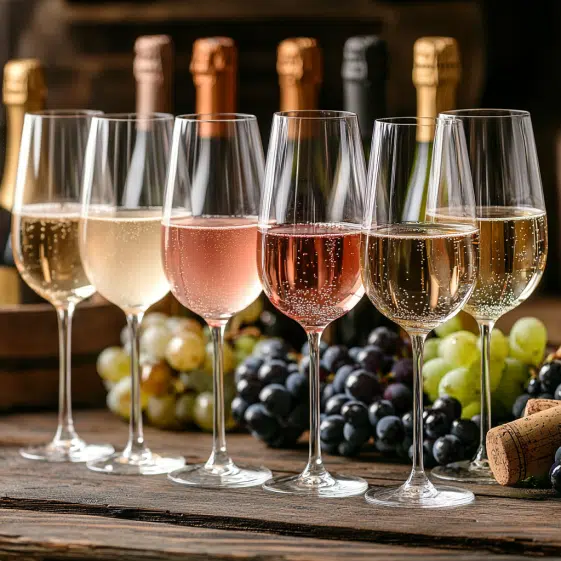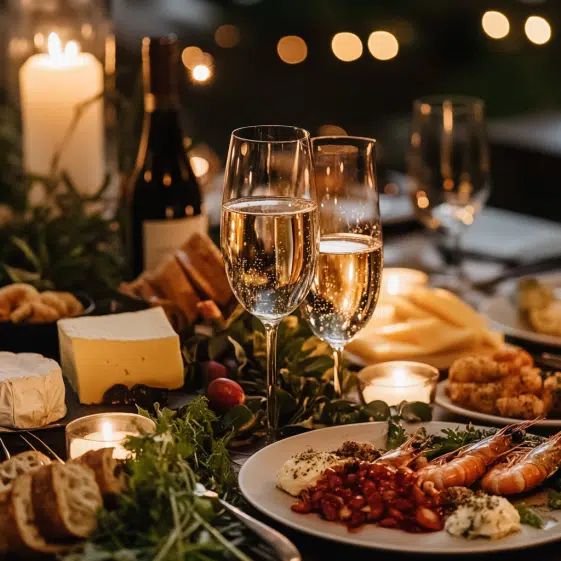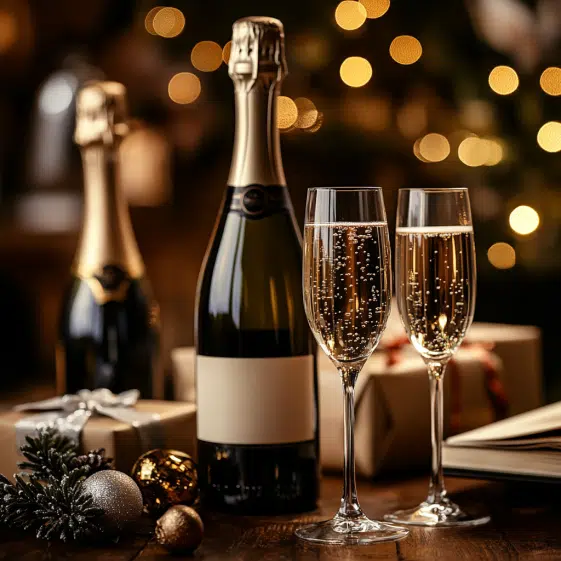A Fresh Look at Sparkling Wines
Effervescence, Flavor, and Fun in Every Sip
What Are Sparkling Wines? A Simple Guide to Bubbles and How They're Made
Sparkling wines are more than just drinks for special occasions—they’re a refreshing, bubbly experience that adds excitement to any moment. Whether it’s a toast at a wedding or a casual brunch with friends, sparkling wines bring a sense of celebration and fun. But what exactly makes a wine “sparkling,” and how do those bubbles get in the bottle? It all comes down to fermentation, pressure, and a little bit of tradition.
At its core, sparkling wine is just wine with bubbles. The fizz you see and feel in sparkling wines is carbon dioxide, which is created naturally through fermentation. What sets sparkling wines apart from still wines is that the carbon dioxide is trapped inside the bottle rather than escaping into the air. When you pop the cork, that built-up pressure is released, and the result is a lively pour of tiny, dancing bubbles. Explore the rich flavors and aromas that make red wine so special. Learn how to choose the perfect bottle and, additionally, check out our guide to the best wine for every occasion. Savor every sip with confidence!

There are a few different ways to make sparkling wines, but the most famous and traditional method is known as the Méthode Champenoise (or Traditional Method). This is the process used to make Champagne in France, and it involves a second fermentation that happens right inside the bottle. After the base wine is made, a mixture of sugar and yeast is added, and the bottle is sealed. The yeast eats the sugar, creating more alcohol and carbon dioxide. Since the bottle is closed, the gas has nowhere to go—so it dissolves into the wine. This method often results in fine, elegant bubbles and complex flavors that develop over time.
Another common technique is the Charmat Method, also called the Tank Method. Instead of a second fermentation happening in the bottle, it takes place in large stainless steel tanks. The wine is then filtered and bottled under pressure to keep the bubbles intact. This method is used for many lighter, fruitier sparkling wines like Prosecco. The result is a fresher, more approachable wine with larger, more playful bubbles. Discover the rich flavors and perfect pairings that make red wine a timeless favorite. Explore our selection and, additionally, check out our guide to the Sweetest Red Wine for those who love a smooth, fruity touch. Sip and enjoy!
There are even more ways to make sparkling wines, such as the Carbonation Method, where carbon dioxide is added directly—similar to how soda is made. While this is a less traditional approach, it’s a quick and affordable way to produce sparkling wine, especially for everyday drinking.
The world of sparkling wines is incredibly diverse. You’ll find everything from bone-dry styles to sweet, dessert-friendly versions. They can be white, rosé, or even red in some cases. The type of grapes used, the method of production, and the region they come from all play a role in the final taste and texture. For example, Champagne tends to be more yeasty and complex, while Prosecco is known for being light, fruity, and refreshing.
No matter which style you choose, sparkling wines offer something special. The bubbles enhance the aromas, make the wine feel crisp on the tongue, and bring out a certain energy in every sip. Whether you’re new to wine or just curious about what makes sparkling wines so enjoyable, learning a bit about how they’re made adds a new layer of appreciation to every glass.
Champagne
When people think of sparkling wines, the first name that usually comes to mind is Champagne. It’s often seen as the gold standard for bubbles, but it’s only one part of a much bigger, more exciting world. Sparkling wines are made in many countries, each offering their own twist on the style. From crisp and refined to fruity and playful, there’s a sparkling wine for every occasion and every palate.
Champagne comes from the Champagne region in France and is made using a strict and traditional method. Only certain grapes are allowed—Chardonnay, Pinot Noir, and Pinot Meunier—and the wine must undergo a second fermentation inside the bottle. This method creates fine, long-lasting bubbles and gives Champagne its signature taste: often dry, complex, and with hints of toast, citrus, and almond. Because of the time and care that go into making it, Champagne tends to be one of the more expensive types of sparkling wines, but many find it worth the splurge.
If you’re looking for something more budget-friendly, Cava is a great place to start. It’s Spain’s answer to Champagne and is made in a very similar way, with secondary fermentation in the bottle. Most Cava comes from the Catalonia region and is made with native Spanish grapes like Macabeo, Xarel·lo, and Parellada. Cava usually offers a drier, more mineral-driven profile, and while it may not have the same level of fame as Champagne, it holds its own in terms of quality and taste—often at a much lower price point.
Another popular name in the world of sparkling wines is Prosecco, which hails from Italy. Unlike Champagne and Cava, Prosecco is made using the Charmat Method, where the bubbles are created in large tanks rather than in the bottle. This gives Prosecco its fresh, fruity, and vibrant character. It’s typically made from the Glera grape and is known for flavors like green apple, pear, and white flowers. Prosecco tends to be a bit sweeter and lighter, making it a go-to for brunches, parties, or casual sipping.

For those who enjoy something a little different, there’s Crémant, another French sparkling wine. While it’s made with the same method as Champagne, Crémant comes from other regions in France, such as Alsace, Burgundy, and the Loire Valley. Because it’s not from Champagne itself, Crémant is usually more affordable while still delivering that elegant French sparkle. Each region adds its own twist based on the grapes and local winemaking styles.
Beyond these well-known types, sparkling wines are produced all over the world—from the U.S. to South Africa to Australia. Each region offers unique expressions, whether it’s a crisp California sparkler made from Pinot Noir and Chardonnay or a fruity sparkling Shiraz from Australia. The styles range from dry and refined to bold and sweet, proving that sparkling wines aren’t limited to one flavor or feeling.
Exploring different types of sparkling wines is part of the fun. Every bottle tells a story—of place, process, and personality. Whether you’re popping a cork to celebrate or simply enjoying a glass at the end of the day, there’s a sparkling wine out there ready to suit the moment.
Food Pairing with Sparkling Wines: Dishes That Bring Out the Best Bubbles
Sparkling wines are often seen as the go-to drink for celebrations, but their versatility at the table is something worth exploring. From appetizers to main courses and even dessert, the right dish can make those bubbles shine. The natural acidity, freshness, and effervescence of sparkling wines make them surprisingly food-friendly, and they can balance rich flavors, highlight delicate ingredients, and refresh the palate between bites.
One of the best-known pairings is sparkling wine with salty snacks. There’s something magical about how bubbles interact with salt and fat. A classic example is potato chips or buttered popcorn with a glass of dry Champagne. The crunch and saltiness of the snack enhance the wine’s crispness, while the bubbles cut through the richness. It’s simple, but it works beautifully. Similarly, fried foods like tempura, fried chicken, or arancini pair well with sparkling wines, thanks to the wine’s ability to cleanse the palate and keep the flavors feeling light.

Seafood is another natural match for sparkling wines. Oysters, shrimp, scallops, and sushi all pair wonderfully with a glass of bubbly. The freshness of seafood brings out the bright acidity in the wine, while the bubbles amplify the texture and subtle flavors. A dry sparkling wine, like a Brut Champagne or Cava, is especially good with raw or lightly cooked seafood dishes. For sushi lovers, a dry Prosecco or a sparkling rosé can bring an added layer of fruitiness that complements both the fish and the rice.
When it comes to cheese, sparkling wines hold their own surprisingly well. Soft cheeses like Brie or Camembert pair nicely with sparkling wines, especially those with a creamy texture. The acidity of the wine cuts through the richness of the cheese, while the bubbles keep your taste buds refreshed. Even stronger cheeses like blue cheese can work with slightly sweeter sparkling wines, like a Demi-Sec or Moscato-based option, offering a perfect balance between salty and sweet.
Sparkling wines also shine alongside spicy dishes. Whether it’s Thai food, Indian curries, or spicy Mexican cuisine, the bubbles and chill of the wine can help tame the heat. A slightly off-dry sparkling wine, such as a sweeter Prosecco or Lambrusco, adds a cooling element that softens the spice without dulling the flavor. It’s a great way to enjoy bold food without overwhelming your palate.
And yes, sparkling wines absolutely belong at dessert. Think fruit tarts, lemon bars, or anything with berries and cream. A sparkling Moscato or a sweet rosé can highlight the natural sweetness of the dessert without making things feel too heavy. Even dark chocolate desserts can work when paired with a rich, slightly sweet sparkling red.
The beauty of sparkling wines is their balance—they have the acidity, freshness, and effervescence to match with so many different types of food. Whether you’re planning a full meal or just putting together a snack plate, there’s a sparkling wine out there that can elevate the flavors and make the whole experience more enjoyable. It’s all about finding the right match and letting the bubbles do the rest.
Choosing Sparkling Wines for Any Occasion: Tips for Gifting, Celebrating, or Relaxing
Sparkling wines have a special way of turning even the simplest moment into something memorable. Whether you’re celebrating a milestone, looking for the perfect gift, or just winding down after a long day, there’s a bottle of bubbles that fits the mood. While it’s easy to associate sparkling wines with big toasts and formal events, they’re incredibly versatile and can bring a little extra joy to everyday occasions too.
When it comes to celebrating, sparkling wines are a natural choice. The pop of the cork, the rising bubbles, and the crisp, refreshing taste all feel like a moment worth savoring. For weddings, anniversaries, or birthdays, classic Champagne is always a solid pick. Its fine bubbles and elegant flavors make it feel luxurious and meaningful. If Champagne is a bit out of budget, Cava from Spain or a good-quality Prosecco from Italy can offer the same celebratory feel without the high price tag. These wines still have that festive sparkle but are often lighter and fruitier, which many guests enjoy. Enhance your dining experience with the perfect red wine pairings. Discover rich flavors that complement every dish and, additionally, explore our guide on Wine with Turkey for a delicious combination. Cheers to great taste!
For more casual get-togethers, sparkling wines can bring a playful, easygoing vibe. A sparkling rosé, for example, works well for brunches, picnics, or a relaxed evening with friends. It’s bright, fruity, and fun to drink, with just enough sweetness to keep things lighthearted. If you’re serving snacks or appetizers, a dry sparkling wine like Brut pairs well with everything from cheese boards to finger foods.
Gifting sparkling wines is also a thoughtful gesture that feels a little more special than a standard bottle of red or white. When choosing a bottle to give, think about the occasion and the person you’re giving it to. For a close friend or someone who enjoys wine regularly, a bottle of Crémant (a French sparkling wine made using traditional methods) might be a unique and appreciated choice. If you’re giving to someone you don’t know well or bringing something to a party, Prosecco is usually a safe bet—it’s widely liked and approachable. You can also find sparkling wines with beautiful packaging or in gift sets, which add an extra touch without needing much effort.

Not every moment with sparkling wines needs to be a celebration. Sometimes, a glass at the end of a long day is just what you need to unwind. For this, look for lighter styles with lower alcohol content, like a Moscato d’Asti or a sparkling Lambrusco. These wines are easy to sip, not too heavy, and often a bit sweet—perfect for a quiet evening at home with a good meal or dessert. See also Homepage
The key to choosing sparkling wines for any occasion is to consider the atmosphere, the people, and the food. It’s not always about picking the most expensive bottle or the fanciest name. It’s about finding a wine that fits the moment, enhances the mood, and brings people together. Whether you’re raising a glass in celebration or enjoying a quiet moment alone, sparkling wines have a way of making it feel just a little more special. We invite you to visit 1A Group, a page full of amazing Artificial Intelligence tools designed to make your life easier and enhance your projects. Additionally, you will find interesting and up-to-date information on a wide variety of topics of interest.
